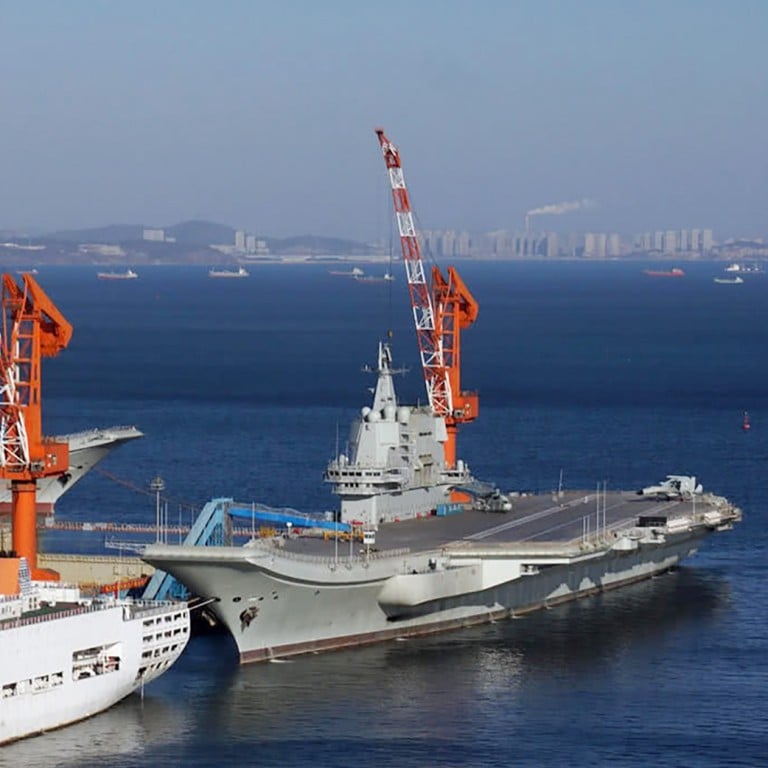
China will build 4 nuclear aircraft carriers in drive to catch US Navy, experts say
- Beijing expected to have at least six aircraft carrier battle groups by 2035 after it prioritised modernising its navy
- Nuclear-powered carriers thought to be equipped with electromagnetic launch catapults similar to those of the US
Four of at least six aircraft battle groups China plans to have in the water by 2035 will be nuclear-powered, as the Asian giant tries to equal the US in naval strength, according to Chinese military experts.
The specialists said that after decades of trying to close the gap, the People’s Liberation Army (PLA) Navy’s hardware might by then be closer to matching the world’s leading superpower in aircraft carrier technology – but it would still lag in real combat experience.
All of China’s new carriers were expected to be equipped with electromagnetic catapults similar to those used by the United States, the experts said. The US’ electromagnetic aircraft launch system, known as EMALS, can launch more aircraft more rapidly than the older diesel systems.
China has one aircraft carrier in service – the Liaoning, commissioned in 2012 – and the Type 001A, the first carrier built in the country, which is still being tested.
“China’s nuclear-powered aircraft carriers with [EMALS-like systems] are expected to join the navy by 2035, bringing the total number of carriers to at least six – although only four will work at the front line,” Wang Yunfei, a naval expert and retired PLA destroyer naval officer, said.
“The country needs to keep developing until it is at the same level as the United States.”
Beijing is keen to expand its aircraft carrier battle groups to fulfil its global naval ambitions and defend its growing overseas interests. Construction of its next conventional diesel-powered aircraft carrier, the Type 002 – the first equipped with the electromagnetic launchers – began last year.
Wang said the budget for the carrier projects would not be cut despite an economic slowdown and a trade war with the US.
After a fourth sea trial, China’s Type 001A aircraft carrier may go into service within months
“Even if the economic downturn has an effect, we can adjust proportions in total military expenditure to make sure naval modernisation keeps going,” he said. “For example, we can cut the number of new tanks.
“The budget for military modernisation will not be cut, even if [Beijing] decided to [use force to] reunify Taiwan. In a war scenario, [Beijing] may reduce spending on things like infrastructure, but it would increase military expenditure.”
President Xi Jinping has ordered the PLA to modernise by 2035 and become a top-ranked fighting force by 2050. Song Zhongping, a television military commentator in Hong Kong, said China’s fleet of aircraft carriers would expand to reflect its global standing.
With the PLA planning to have four nuclear-powered carrier battle groups on the front line by 2035, the Type 001A and its next-generation carrier Type 002 would become temporary battle ships, Song said.
Chinese President Xi Jinping gives army its first order of 2019: be ready for battle
“The Type 002 – a conventionally powered carrier with an EMALS-like system – may become the only one of that kind of aircraft carrier, because China will next build multiple nuclear-powered aircraft battle platforms,” Song said.
Both Wang and Song said the Liaoning would be replaced by the Type 001A by 2035, by which time the Liaoning would be obsolete. The Liaoning was refitted from a half-built Soviet hull bought from Ukraine in 1998 and is used to train carrier crews.
The PLA Navy will develop one of its fighter jets for use on its aircraft carriers, with debate ongoing over whether that will be the FC-31 or J-20. China has just one type of carrier-based fighter jet, the J-15, whereas the US has two.
Wang said Chinese engineers were developing a next-generation carrier-based fighter, describing it as a variant of the FC-31 stealth fighter, whose fighting capability may be “a little bit behind the US’ F-35C”.
Song said China’s overall strength would remain limited by a lack of combat experience.
“China’s aircraft carrier technology and its carrier-based fighter jets will be developed to match the same generation of their American counterparts, but hardware build-up is only part of the picture,” he said.
“The standard of warships’ crew training and damage control have remained key shortcomings of the PLA Navy, because they has not had as much real combat experience as the Americans.”


